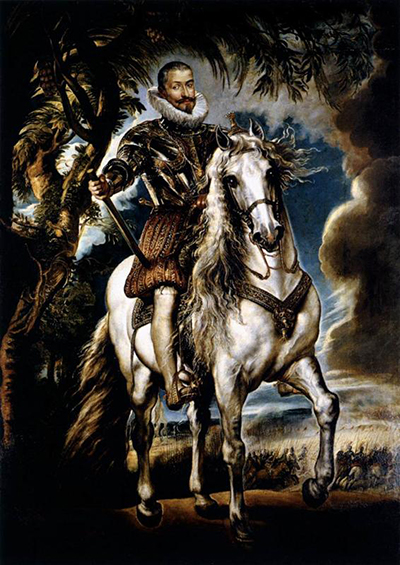This painting from 1603 is one of several equestrian-based portraits by Flemish master Peter Paul Rubens
The artist understand both the beauty and power of victory as well as the pain and suffering of war. His complex composition of the Consequences of War communicates exactly that, whilst several portraits provide flattering depictions of soldiers upon the battlefield.
These types of portraits also serve to remind us as to the attire of soldiers all these centuries ago, with few original outfits still in existence. Many art museums will place paintings alongside other collections of medals, costumes and weaponary in order to complete a comprehensive display on a particular event or period of time.
This huge portrait stands at approximately three metres tall by two metres wide and this size of canvas was common throughout his career. Some of the commissions that he earned were for prestigious locations in institutions across Europe, requiring large scale solutions.
In the present day these are much rarer, with standard canvas sizes being much smaller to match the changes to interior design and architecture that have taken place since the time of Rubens.
There have been many other powerful miltary figures depicted in battle scenes, or perhaps pre-planned set ups in the style of war. Saint Martin and the Beggar from El Greco continues the equestrian theme. The most famous battle scene must surely be Liberty Leading the People by Eugene Delacroix, both for the beauty of the painting and the significance of the scene. Rubens also depicted Louis XIII in military clothing.
There are similarities between Rubens' work here and Titian's Portait of Carlos V in Mühlberg, with this famous Flemish artist known to have studied his work closely and incorporated some of the Italian's ideas into his own work. The artist carefully wraps the subject in an encasing of palm trees which places even greater emphasis on the powerful figure and his horse.
Rubens also attempts to give an impression of movement, as if they are approaching the viewer. It is believed that his own equestrian portraits would then influence others later on, underlining how ideas and techniques would be passed from one generation onto the next. Anthony van Dyck, for example, may not have been aware that the approach of Rubens that he so admired had itself been inspired by Titian.




